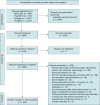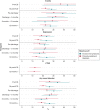Burden of mood symptoms and disorders in implantable cardioverter defibrillator patients: a systematic review and meta-analysis of 39 954 patients
- PMID: 37311667
- PMCID: PMC10264222
- DOI: 10.1093/europace/euad130
Burden of mood symptoms and disorders in implantable cardioverter defibrillator patients: a systematic review and meta-analysis of 39 954 patients
Abstract
Aims: Implantable cardioverter defibrillators (ICDs) prevent sudden cardiac death. Anxiety, depression, and post-traumatic stress disorder (PTSD) are underappreciated symptoms. We aimed to systematically synthesize prevalence estimates of mood disorders and symptom severities, pre- and post-ICD insertions. Comparisons were made with control groups, as well as within ICD patients by indication (primary vs. secondary), sex, shock status, and over time.
Methods: Databases (Medline, PsycINFO, PubMed, and Embase) were searched without limits from inception to 31 August 2022; 4661 articles were identified, 109 (39 954 patients) of which met criteria.
Results: Random-effects meta-analyses revealed clinically relevant anxiety in 22.58% (95%CI 18.26-26.91%) of ICD patients across all timepoints following insertion and depression in 15.42% (95%CI 11.90-18.94%). Post-traumatic stress disorder was seen in 12.43% (95%CI 6.90-17.96%). Rates did not vary relative to indication group. Clinically relevant anxiety and depression were more likely in ICD patients who experienced shocks [anxiety odds ratio (OR) = 3.92 (95%CI 1.67-9.19); depression OR = 1.87 (95%CI 1.34-2.59)]. Higher symptoms of anxiety were seen in females than males post-insertion [Hedges' g = 0.39 (95%CI 0.15-0.62)]. Depression symptoms decreased in the first 5 months post-insertion [Hedges' g = 0.13 (95%CI 0.03-0.23)] and anxiety symptoms after 6 months [Hedges' g = 0.07 (95%CI 0-0.14)].
Conclusion: Depression and anxiety are highly prevalent in ICD patients, especially in those who experience shocks. Of particular concern is the prevalence of PTSD following ICD implantation. Psychological assessment, monitoring, and therapy should be offered to ICD patients and their partners as part of routine care.
Keywords: Anxiety; Cardiac; Depression; ICD; PTSD; Shocks.
© The Author(s) 2023. Published by Oxford University Press on behalf of the European Society of Cardiology.
Figures







References
-
- Bardy GH, Lee KL, Mark DB, Poole JE, Packer DL, Boineau Ret al. . Amiodarone or an implantable cardioverter-defibrillator for congestive heart failure. N Engl J Med 2005;352:225–37. - PubMed
-
- Moss AJ, Hall WJ, Cannom DS, Daubert JP, Higgins SL, Klein Het al. . Improved survival with an implanted defibrillator in patients with coronary disease at high risk for ventricular arrhythmia. Multicenter automatic defibrillator implantation trial investigators. N Engl J Med 1996;335:1933–40. - PubMed
-
- Moss AJ, Zareba W, Hall WJ, Klein H, Wilber DJ, Cannom DSet al. . Prophylactic implantation of a defibrillator in patients with myocardial infarction and reduced ejection fraction. N Engl J Med 2002;346:877–83. - PubMed
-
- Blanch B, Lago LP, Sy R, Harris PJ, Semsarian C, Ingles J. Implantable cardioverter-defibrillator therapy in Australia, 2002–2015. Med J Aust 2018;209:123–9. - PubMed
-
- Kurtz SM, Ochoa JA, Lau E, Shkolnikov Y, Pavri BB, Frisch Det al. . Implantation trends and patient profiles for pacemakers and implantable cardioverter defibrillators in the United States: 1993–2006. Pacing Clin Electrophysiol 2010;33:705–11. - PubMed
Publication types
MeSH terms
Grants and funding
LinkOut - more resources
Full Text Sources
Medical
Miscellaneous

